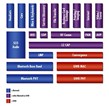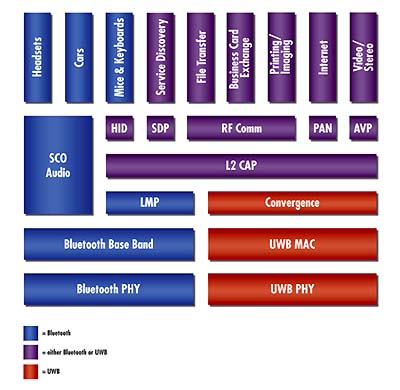Bluetooth, UWB Tie The Knot

Bellevue, WA -- The Bluetooth Special Interest Group (SIG) announced its intent to work with the developers of ultra wideband (UWB) technology to combine strengths of both technologies. This decision will allow Bluetooth technology to extend its long-term roadmap to meet the high-speed demands of synchronizing and transferring large amounts of data, as well as enabling high quality video applications for portable devices. UWB will benefit from Bluetooth's maturity, qualification program, brand equity, and comprehensive application layer.
While details are still being worked out, the goal is to work towards an architecture that allows devices to take advantage of UWB data rates for scenarios that require high speed. Bluetooth will still be important to maintain backward compatibly with existing devices on the market and future products not requiring the higher data rate.
"It has been apparent that members of the Bluetooth SIG would like to enable products with higher data rates. I feel that it is the responsibility of the industry to recognize synergies and limit fragmentation as much as possible," said Michael Foley, executive director of the Bluetooth SIG. "Joint development between Bluetooth technology and UWB is the fastest and most economical pathway for both technologies to meet the future demands of companies and end users. At the same time it is important to understand that Bluetooth is a global standard to a great extent driven by the adoption into mobile consumer devices like mobile phones, so not only is a requirement that worldwide regulation is achieved but also that it is done in a way so co-existence with future mobile standards is realized."

Not surprisingly, the two main UWB industry camps -- the WiMedia Alliance and the Freescale Semiconductor-led UWB Forum -- were quick to respond to the announcement.
The WiMedia Alliance, which recently merged with the MultiBand OFDM Alliance Special Interest Group (MBOA-SIG), applauded the Bluetooth SIG's announcement. "The Bluetooth SIG is setting a great precedent today," Stephen R. Wood, president of the WiMedia Alliance, said. "Both technologies now stand to achieve greater things as we move together toward the ideal, easy-to-use products that allow consumers to enjoy their content and devices without being physically tethered to a network."
Freescale announced its intention to support the collaborative effort for using UWB technology as the high-speed solution launched by the Bluetooth SIG. "UWB is a compelling technology for mobile and high-speed wireless designers, but it doesn't yet have the infrastructure required to truly impact the industry," said Martin Rofheart, director of the Ultra Wideband Operation at Freescale. "We deeply value the expertise of the Bluetooth SIG and its learning in profile and applications for personal area networks. By marrying DS-UWB and Bluetooth through an industry-developed protocol adaptation layer, we will dramatically enhance existing applications and profiles and enable new wireless user experiences."
With this collaborative approach, the Bluetooth SIG believes it will be possible to maintain existing Bluetooth core values like low power, low cost, and unique ad hoc connectivity while enabling future usage scenarios requiring higher data throughput. Such an example would be streaming high quality video between portable devices. As digital content size increases, the bit rate required to move data from device to device increases. As such, a classic Bluetooth usage scenario today of exchanging a file is more likely to require UWB speeds in the future.
UWB will benefit from Bluetooth technology's brand equity, market penetration, and technical and organizational maturity. UWB can skip many time-intensive and costly hurdles in technology and market development by joining forces with a technology that is past that stage. Not only do companies want to leverage investments in Bluetooth technology, but 250 million consumers who also invested in Bluetooth technology will want those devices to work with future high data rate WPAN products.
"The potential merger of Bluetooth and UWB is something that has been openly speculated about for some time," ABI Research senior analyst Dan Benjamin commented. "UWB could replace the existing air interface used by Bluetooth for the purpose of drastically increasing the total bandwidth available for Bluetooth devices. At the same time, the Bluetooth profiles and network stacks could easily be used to limit the amount of development needed for new devices, since Bluetooth and UWB target the same market for short range cable replacement."
"The downside," Benjamin added, "is that backwards compatibility will be limited. Bluetooth implementing UWB could serve to limit interest in Wireless USB, which also uses UWB as an air interface and targets a similar market, but is still very much unsettled with regard to software and authentication."
Before bringing products to the global market some fundamental issues of UWB need to be resolved, like interference issues for wireless LAN (WLAN), WiMax, and new cellular bands, in addition to the lack of a worldwide spectrum allocation for UWB.
